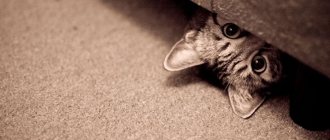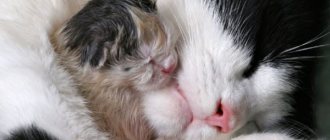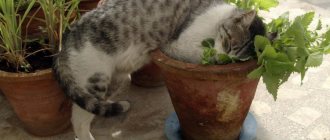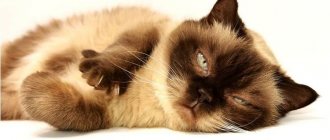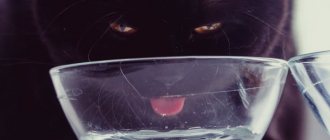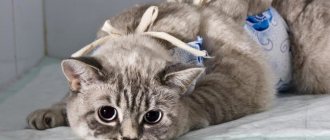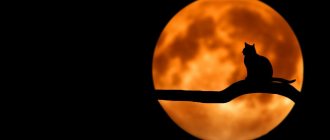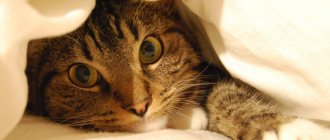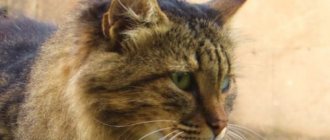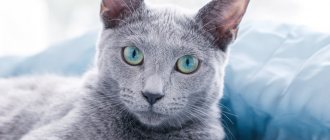Responsible owners always monitor the living conditions of their pets, so any oddities in behavior do not go unnoticed. It is very important to maintain a constant amount of food, water and vitamins. This is the only way the pet will remain healthy. That is why, when it is discovered that a cat drinks a lot of water, you need to quickly identify the cause and regulate the animal’s regime.
About the norm
Changing your pet's needs is not always a bad thing! Therefore, there is no need to panic if your cat drinks a lot of water. The reason may be completely harmless, and the consequences of changing the drinking regime will not affect the animal’s well-being at all. Felinologists do not have a definite figure for mandatory water consumption - this number depends on nutrition, climate, breed, age and many other factors.
Attention! Do not try to force water on a healthy cat! With rude actions you will not only not achieve the desired result, but will also frighten your pet. The animal, as a rule, knows very well how much water it needs!
Typically, veterinarians advise calculating the amount of required moisture so that there is 0.03 milliliters of liquid per gram of pet’s body weight. It doesn’t have to be just water; milk, canned food, and wet food will do.
It is very important to pay attention to your pet's diet. If a cat drinks a lot of water, the reasons may lie solely in a change in diet. Dry food tends to “pull” moisture from the animal’s body. Because of this, it is recommended to equalize the amount of water to the weight of food in a ratio of 1:3.
Consumption rate
There are no general water consumption standards for cats. Their need for fluid depends on many factors - weight, age, individual characteristics and general health. You can calculate the approximate rate of water consumption for a cat: about 30 ml of water is required per kilogram of weight. Based on these data, it turns out that a cat that weighs 7 kg should drink 200 ml of water per day, that is, 1 glass.
- Thirst torments...
Attention! With age, a cat's need for water increases due to the natural decrease in the amount of fluid in the body. That's why older pets drink more than young ones.
Diseases
Diabetes mellitus in a pet is one of the diseases that causes constant thirst. The cat's pancreas stops producing the required amount of the hormone insulin, which leads to problems delivering glucose to the cells. The necessary substance does not reach the kidneys in sufficient quantities. An important organ cannot filter moisture properly, and the cat quickly loses water.
Chronic renal failure is a very common incurable disease in older animals. Cells in an important organ cease to function normally and retain the required amount of moisture.
If your cat drinks a lot of water, then it is likely that you are experiencing one of the symptoms of hepatitis. The disease is caused by inflammatory processes in the liver. With proper treatment, the problem can be quite easily dealt with.
Attention! Many viral diseases and inflammatory processes are accompanied by increased thirst. Try to provide your pet with enough water so that his body continues to fight the disease.
Insulinoma (that is, inflammation of the pet's pancreas) is also accompanied by the fact that the cat often drinks water. The reasons for increased thirst also lie in excess insulin production. It is extremely rare in cats.
The cat drinks a lot of water and loses weight
Thirst and weight loss are a formidable pathological symptom.
The combination of thirst and weight loss develops in the following situations:
- poor nutrition;
- pathologies of the urinary tract;
- poisoning leading to vomiting and diarrhea;
- hormonal disorders;
- diabetes.
If a cat feeds on table scraps, a lot of salt and spices enter the body. When feeding only meat or fish, an excess of proteins occurs. The body spends a lot of energy processing such food, and the absorption of nutrients remains low.
When protein overfeeding, uric acid or other uric salts are formed, which are poorly soluble in blood or urine. If it is not possible to remove toxins, self-poisoning develops. That's why the cat drinks all the time. The struggle for survival comes to the fore; there is no time to digest the consumed food. To stop the intake of toxins, you need to stop eating.
In case of urolithiasis or cystitis, the primary task is to prevent salt crystallization. To prevent oversaturation of solutions, they are diluted with drunk water.
Be sure to read:
The cat doesn’t eat, only drinks water, is lethargic: reasons for what to do if he refuses to eat and sleeps
In renal failure, the kidneys are unable to filter certain substances, such as phosphates. In elevated concentrations the compounds are poisonous. They have to be diluted. For the same reason, thirst occurs in diabetes mellitus: you need to dilute the glucose.
Natural causes
Often, owners, asking the question “Why does the cat drink a lot of water?”, unnecessarily dramatize the situation. Don’t forget about the completely natural (and harmless!) reasons for your pet’s increased need for water:
- increased physical activity (long walks, hyperactivity, playfulness, training);
- increased room temperature, stuffiness, hot season;
- pregnancy or lactation period;
- age (kittens practically do not need additional moisture, and older animals drink a lot);
- dietary habits (dry food or salted foods).
Don't worry or worry too much. If there are no other alarming symptoms in your pet’s behavior, then you just need to give your pet a little more water than usual.
Attention! It is necessary that the water in the drinking bowl is always fresh (changed every day). Do not give your pet tap water or distilled water. It is recommended to leave the filtered or boiled liquid in a bowl in a visible place. The pet must have free access to it.
Why does a cat drink a lot?
The reasons why a cat consumes an increased amount of fluid can be divided into physiological and pathological.
The first group includes the following factors not related to organ pathology:
- Pregnancy, lactation period.
- Recovery period after surgery.
- Excessive physical activity.
- Hot weather.
- High salt content or insufficient protein in the diet.
- Using certain foods, such as rice, which have similar effects to furosemide in animals.
- Dry food. Manufacturers also do not recommend changing food unless necessary.
- Dry indoor air.
- Dampness.
- Elderly age. Kittens, as a rule, drink little, but polydipsia is often observed in older animals.
These reasons do not pose a risk to the cat's health. As soon as her condition is restored or the factors are eliminated, thirst will disappear.
Pathological reasons that force an animal to drink a lot include:
- diabetes;
- chronic renal failure;
- viral and inflammatory diseases;
- pyelonephritis;
- insulinoma;
- hyperthyroidism;
- malignant and benign liver tumors;
- hepatitis.
It is not uncommon for a cat to experience abnormal fluid intake due to stress. A change of place of residence, the appearance of another pet in the house, noisy company, or a long absence of owners can contribute to the symptom of polydipsia.
Finally, another reason why an animal constantly drinks water is taking certain medications. This phenomenon is not the norm, but one of the side effects that occurs if the cat is given the wrong treatment or the dosage is exceeded.
Drugs that cause increased thirst include corticosteroids, diuretics, sedatives, in particular Xylazine.
A thirsty cat should never be limited in water. An animal deprived of the opportunity to drink may die. There should always be enough water in the bowl; it should be changed daily, and in hot weather - 2-3 times a day.
Raw tap or distilled water should not be given to animals; boiled or filtered water is much safer for them. The animal should not be allowed to drink water from the aquarium, much less from the toilet.
Other reasons
However, it also happens that none of the listed reasons are suitable. Then the owners do not understand why the cat drinks a lot of water, what it means and how to treat it. Among these reasons are:
- increased sweating;
- taking special medications (diuretics, corticosteroids, sometimes due to side effects of sedatives or painkillers);
- loose stools;
- discharge from the genitals;
- dropsy (a disease characterized by the accumulation of fluid in the cavities and tissues of the body);
- stress and mental disorders;
- brain pathologies.
If you notice that your pet is drinking much more water than usual, you should first conduct a home examination, and then (if there is no harmless explanation) contact your veterinarian!
Help for the animal and medications
There is no reason to panic if the cat's thirst is caused by natural reasons. After weaning the offspring, the female will stop drinking a lot within a few days. When feeding dry food, you must ensure that the bowl of water is always full and alternate dry formulas with wet canned food.
A bowl of water is required
Feed should not be over-salted. If medications are the cause of thirst, it is worth discussing it with your veterinarian. He will adjust your medication intake.
If a cat drinks a lot and this is accompanied by vomiting, prolonged diarrhea, lethargy, and apathy, then it is necessary to take the animal to a veterinary clinic. The specialist will do blood and urine tests, check hormonal levels and conduct an ultrasound if diabetes is suspected. Drug therapy is prescribed by a veterinarian after an examination.
Please note that an animal may experience severe thirst during burns, even chemical ones, when fluid evaporates from the body and the body experiences a lack of moisture. Often, cats drink a lot of water when in heat due to blood loss. This indicates health problems.
Gastrointestinal diseases
Problems with the gastrointestinal tract in cats are determined by the following signs:
- vomit;
- diarrhea;
- discharge containing mucus;
- bloating;
- hard and tense stomach;
- strong odor from the mouth.
Among the most common problems is gastritis or the accumulation of hair in the stomach.
It’s not difficult to deal with a hairball: drinking plenty of fluids and special medications that help remove hair from the stomach will solve this problem (for example, “Phytomins”).
But gastritis is somewhat more complicated; its treatment requires time and effort. At the initial stage, it is necessary to give the cat boiled water and rice water. Then they use activated carbon diluted in water and medications prescribed by the doctor (most often these are stomach drops, Almagel). Food should be low-fat and exclusively unsalted.
Vomiting in a cat - poisoning and more
In addition to the first version that comes to mind, that the cat was poisoned, there are a number of other reasons for the malaise.
The most important thing to note is severe overeating. If an animal has been hungry for a long time and then eats a lot, the stomach does not have time to cope with the load. Excess food is eliminated naturally.
Animals can independently regulate vomiting processes, relieving themselves of the feeling of heaviness and discomfort in the abdomen.
If the food was eaten too quickly, it is possible that the walls of the esophagus were strongly irritated by something, which also led to vomiting.
Be sure to monitor your pet's diet. Feeding foods that are difficult and take a long time to digest creates additional problems with the gastrointestinal tract. If you feed your cat dry food, it may be worth switching to a different one.
Recommendations for improving the condition:
- Analyze what the animal has eaten recently. Perhaps the condition was affected by a new product or food that had not been introduced into food before.
- For constipation combined with vomiting, give an enema. Toxins accumulated in the body will be eliminated faster.
- Cats with long, thick hair require thorough brushing every day. It is very likely that the cause is wool stuck in the stomach.
Medicines
Medications are another cause of unnatural thirst. In addition, this is considered abnormal, a side effect of the drug. It can also occur as a result of improper treatment. Drugs that cause cats to drink a lot of fluids include the following:
- diuretics;
- corticosteroids.
An increase in the desire to drink when taking xylazine has also been noticed, but this is a fairly rare case of side effects.
If you experience problems with water consumption while taking medications, you should contact your veterinarian. The doctor will determine the degree of threat and decide what to do - continue treatment as standard, reduce the dosage, or completely abandon the drug.
Treatment of polydipsia
When a cat begins to drink a lot of water, the exact cause of the phenomenon is first determined. Thirst caused by natural factors is harmless. Polydipsia goes away, for example, in a nursing cat after weaning the babies. Increased water consumption caused by the cat's diet also normalizes after adjusting the animal's menu. Veterinarians state that dry food provokes thirst in cats, so you should not feed your pet only this. The diet should be varied, with a small amount of salt.
When thirst is increased due to the effects of a prescribed medication, this is abnormal. You need to contact your veterinarian to review the treatment regimen, stop taking the drug that causes extreme thirst, and replace it with another drug. If the symptom is not associated with organ ailments, and the cat drinks a lot due to stress, then veterinarians recommend preventing the pet’s desire to get drunk. After time, the density of urine will be restored to normal levels without negatively affecting the health of the animal.
If you suspect the development of the disease, you must contact your veterinarian for a full examination of the animal.
When a cat begins to drink a lot of water, and there are suspicions that this is a sign of a possible disease, it is necessary to have the pet examined at a veterinary clinic. Using laboratory tests of urine and blood, as well as instrumental diagnostic methods, a specialist will determine the pathology that provokes thirst and prescribe appropriate therapy. Some diseases are incurable, but with proper care the cat can live an active life for a long time.
How to know how much water your cat should drink
On average, a cat needs about 200 ml of water per day, which corresponds to 20-40 ml per 1 kg of animal weight. In order to know the physiological needs of your pet, it is better to constantly monitor how much he drinks in a normal environment for his body. Measure how much water you pour into your cat's container. The next day, measure how much is left. If you added water several times, take these amounts into account when measuring. In a few days it will become clear how much water a cat needs on average every day.
And if the deviation becomes large, you will need to look for the reason why the cat drinks a lot, whether it is caused by an illness. Or she simply accidentally ate a piece of herring, or was too active on hot days, and is now compensating for the lack of water.
What awaits the owner at a later date?
How to calculate the first signs of pregnancy in a cat was described here. But what to do if the term is coming to an end, childbirth is on the horizon and the breeder is worried whether everything will go well or whether help will be needed.
Veterinarians at the RosVet VC advise you to worry in advance about the presence of a specialist during childbirth, especially if the pregnancy is difficult and the birth is the first. There are a lot of unforeseen situations when the help of a specialist will be invaluable and he will save the life of not only newborn kittens, but also the cat itself.
A cat's pregnancy lasts 57-63 days (max. up to 70); calculating the due date is easy if you know the day of mating. The time from conception to childbirth is usually divided into 6 periods:
- I – from 0 to 20 days, symptoms are practically not noticeable, only the nipples become bright red and food preferences change slightly;
- II – 20-30 days, the stomach is tense; if you swipe it, you might think that the cat has eaten a lot;
- III – 5th week, moment “X”, when the most ignorant owner will notice signs of pregnancy in a cat. The belly is rounded, you can feel the fruits;
- IV – 5-6 weeks, first movement of the fetus, the stomach goes to the sides;
- V – 42-50 days of pregnancy, the kittens are moving with all their might, on ultrasound you can notice the size of the fetuses (up to 8 cm) and the presence of fur (except for sphinxes);
- VI – 50-before birth, active movement, if the cat is lying down, you can notice the movement of the kittens under the skin of the abdomen. The appetite is excellent, the cat eats almost constantly.
That is, at a later date, the presence of fruits is obvious and the owner needs to prepare for the birth of the pet. To do this, it is important to prepare a place, often a large box, in which the cat feels comfortable and relatively protected. The place should not be on the aisle, away from drafts and equipment that makes noise.
Childbirth in a cat. Preparation
Before the birth begins, the owners must take care of a special place for it. A cat can give birth in a deep and spacious cardboard box, with ventilation slits in the side walls. The bottom of the box should be covered with several layers of newspaper and covered with a clean rag. The box should be placed in a quiet corner. The animal must be introduced to this box in advance.
When the female feels the approach of labor, she will begin to worry, run around the house, and climb into closets. Pick her up, calm her down and take her to this box.
Physiological causes of increased thirst
Owners often wonder why their cat drinks a lot of water, and forget about the physiological and completely natural causes of increased thirst:
- Intense physical activity.
- Pregnancy and breastfeeding. While carrying kittens, as well as during the period of feeding, cats usually become thirsty. During these periods, the body requires a lot of fluid to form amniotic fluid and produce milk.
- Elderly age.
- Increase in body weight. Cats that are overweight require much more fluid for the normal functioning of the body than their slender relatives.
- Features of the diet. Cats that eat exclusively wet food drink very little water and pee less often because their body's fluid reserves are replenished with food. Accordingly, pets who eat only dry food often experience increased thirst. Also, a cat begins to drink a lot of water when it is suddenly switched from wet food or natural food to ready-made dry food. It contains a small percentage of liquid, and the animal thus replenishes moisture loss.
- Increased air temperature outside and at home.
- Diarrhea. One-time diarrhea in cats does not require medical attention. It can cause increased thirst because diarrhea releases a significant amount of fluid from the body through feces. If a cat's diarrhea recurs more than once a day, the owners should take the animal to the veterinarian.
- Taking certain medications. When treating various diseases, side effects from taking certain medications often occur. For example, cats that take corticosteroids, as well as diuretics, painkillers and sedatives, drink more often.


